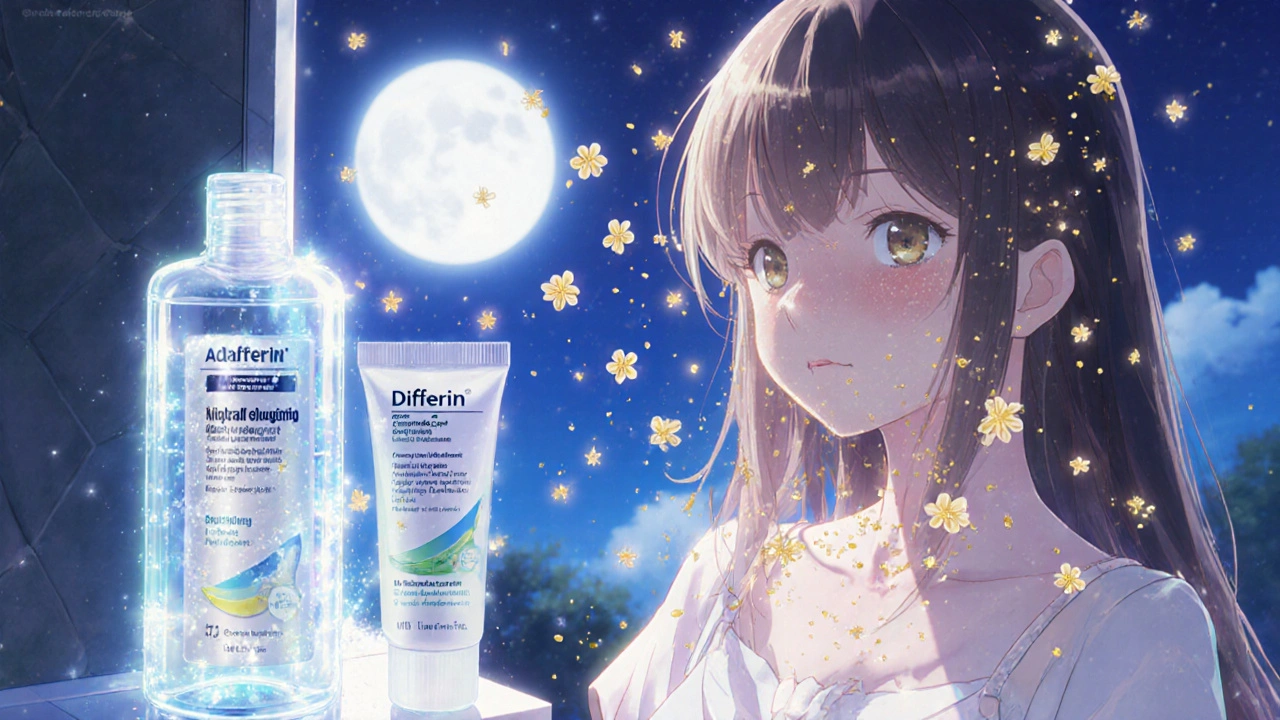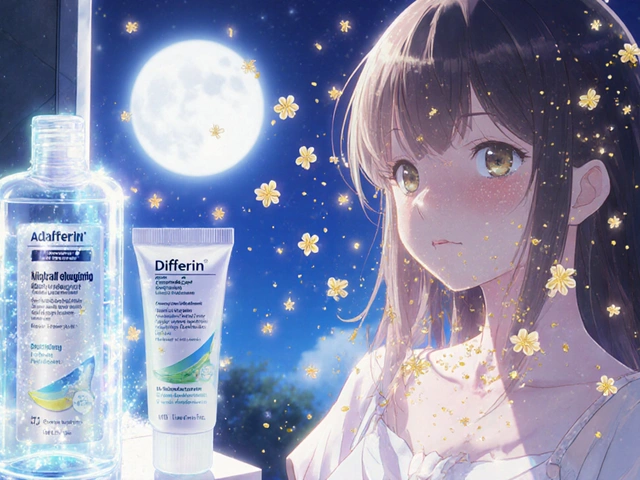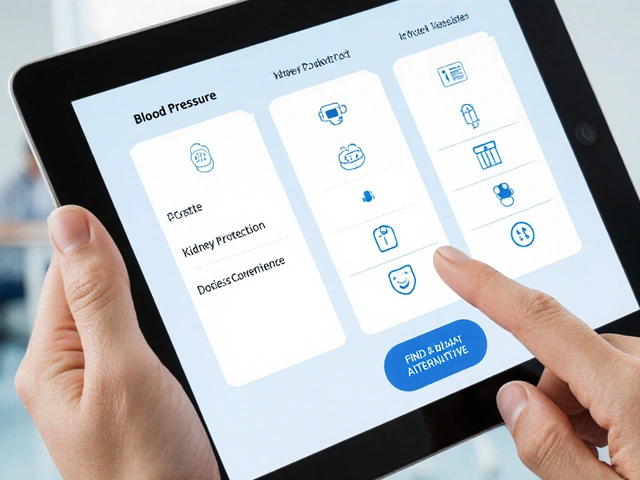Acne doesn’t just bother your skin-it can mess with your confidence, your routine, and even your sleep. If you’ve been using Adaferin Gel (adapalene) and aren’t seeing the results you hoped for, or you’re dealing with irritation, it’s time to look at what else is out there. You’re not alone. Thousands of people switch treatments every year because one product just doesn’t cut it. But not all alternatives are created equal. Some work faster. Some are gentler. Some cost a fraction of what Adaferin does. Let’s break down the real options, what they do, and who they’re actually good for.
What Adaferin Gel (Adapalene) Actually Does
Adaferin Gel contains adapalene, a third-generation retinoid. That means it’s a synthetic cousin of vitamin A, designed to target acne at its source. Unlike older retinoids, adapalene is stable, less irritating, and works well even in low concentrations-usually 0.1% or 0.3%. It doesn’t kill bacteria. Instead, it unclogs pores by speeding up skin cell turnover. That stops blackheads and whiteheads before they turn into angry red pimples. It also reduces inflammation, which helps calm existing breakouts.
Studies show adapalene reduces acne lesions by about 50-60% after 12 weeks of daily use. It’s FDA-approved for mild to moderate acne and is often the first prescription you get if your pharmacist or doctor thinks over-the-counter options like benzoyl peroxide aren’t enough. But here’s the catch: it takes time. Most people don’t see real improvement until week 6-8. And yes, your skin might get dry, flaky, or red in the first few weeks. That’s normal-but not everyone can tolerate it.
Differin Gel: The Same Thing, Different Brand
If you’ve seen Differin Gel on the shelf, you’re looking at the exact same active ingredient as Adaferin: adapalene 0.1%. In New Zealand, Differin is available over-the-counter, while Adaferin is often prescribed. But chemically? Identical. Same formula. Same manufacturer (Galderma). Same results. The only differences? Packaging, price, and where you buy it.
Some pharmacies charge more for Adaferin because it’s branded as a prescription product. Differin, sold over-the-counter, usually costs $25-$35 for a 45g tube. Adaferin can run $40-$55 with a prescription. If you’re paying extra for Adaferin without a medical reason, you’re not getting better acne treatment-you’re just paying for the label.
Bottom line: If Differin works for you, there’s no need to switch to Adaferin. They’re the same drug. Save your money.
Tretinoin: Stronger, Faster, But Harsher
Tretinoin is the original retinoid. It’s been used since the 1970s and is still the gold standard for acne and anti-aging. Unlike adapalene, tretinoin is a first-generation retinoid and much more potent. It works faster-some users see results in 4-6 weeks. It also reduces fine lines and dark spots, which is why dermatologists often prescribe it for people with both acne and early signs of aging.
But here’s the trade-off: irritation. Up to 80% of users experience peeling, redness, burning, or sun sensitivity in the first month. Tretinoin is also unstable-it breaks down in light and air, so it needs to be stored carefully. It’s usually prescribed in concentrations of 0.025%, 0.05%, or 0.1%. The higher the dose, the more aggressive the side effects.
If you’ve tried adapalene and it didn’t work, tretinoin might be your next step. But if you already have sensitive skin, rosacea, or eczema, tretinoin could make things worse. It’s not a better option for everyone-just a stronger one.
Benzoyl Peroxide: The Bacteria Killer
Where adapalene unclogs pores, benzoyl peroxide kills acne-causing bacteria. It’s available in 2.5%, 5%, and 10% strengths, and you can buy it without a prescription. It works fast-often within days. It’s especially good for inflamed, red pimples and pustules. Many people use it in combination with adapalene because they attack acne in different ways.
But benzoyl peroxide has downsides. It bleaches towels, pillowcases, and clothing. It can dry out your skin badly if used alone. And it doesn’t prevent new clogged pores like adapalene does. That’s why dermatologists often recommend using benzoyl peroxide in the morning and adapalene at night. One handles bacteria, the other handles clogs.
If your acne is mostly red, swollen bumps, benzoyl peroxide might be all you need. If you’re getting blackheads and whiteheads too, you’ll need something like adapalene to go with it.

Salicylic Acid: The Gentle Exfoliator
Salicylic acid is a beta hydroxy acid (BHA). It’s oil-soluble, which means it can slip into pores and dissolve the gunk inside. It’s great for blackheads, mild whiteheads, and clogged pores. It’s also anti-inflammatory, so it helps reduce redness. You’ll find it in cleansers, toners, and spot treatments-usually at 0.5% to 2%.
Compared to adapalene, salicylic acid is much gentler. It doesn’t cause the same level of peeling or sun sensitivity. But it’s also less powerful. Studies show it reduces acne lesions by about 30-40% over 12 weeks, while adapalene hits 50-60%. It’s a good starter option for teens or people with sensitive skin. But if you’ve been using it for months and your breakouts haven’t improved, it’s probably not enough.
Salicylic acid works best as a maintenance product after you’ve cleared your skin with something stronger-like adapalene or tretinoin.
Azelaic Acid: The All-Rounder
Azelaic acid is less known but incredibly useful. It’s naturally found in grains and works in three ways: it kills bacteria, reduces inflammation, and gently exfoliates. It’s especially good for people with rosacea or post-acne dark spots (post-inflammatory hyperpigmentation). Studies show it’s as effective as adapalene for inflammatory acne but causes less irritation.
It’s available in 15% and 20% strengths. In New Zealand, you can get it as a prescription cream (like Skinoren) or as a lower-strength OTC serum. It’s safe to use during pregnancy, which makes it a top choice for expectant mothers dealing with acne.
If you’ve had bad reactions to retinoids, azelaic acid is your safest alternative. It doesn’t cause sun sensitivity, doesn’t peel your skin, and doesn’t bleach fabrics. The downside? It takes longer to work-up to 8-12 weeks. And it’s more expensive than adapalene.
Clindamycin: The Antibiotic Option
Clindamycin is a topical antibiotic. It kills acne bacteria and reduces inflammation. It’s often combined with benzoyl peroxide (like in Benzaclin or Clindoxyl) to prevent bacteria from becoming resistant. It’s fast-acting and good for moderate to severe inflammatory acne.
But here’s the problem: antibiotics shouldn’t be used long-term. Overuse leads to resistant strains of bacteria, making acne harder to treat in the future. The FDA recommends limiting topical antibiotics to 3-6 months. After that, you need to switch to non-antibiotic options like adapalene or azelaic acid.
Clindamycin is useful as a short-term booster, not a long-term solution. Don’t use it unless your doctor says so-and always pair it with benzoyl peroxide.

Which Alternative Is Right for You?
Choosing the best alternative to Adaferin Gel isn’t about what’s “best.” It’s about what fits your skin, your lifestyle, and your goals.
- If you want the same results as Adaferin but cheaper → Differin Gel (same thing, different price)
- If you need faster results and can handle irritation → Tretinoin
- If your acne is mostly red, swollen bumps → Benzoyl Peroxide
- If you have sensitive skin or are pregnant → Azelaic Acid
- If you’re just starting out and want something gentle → Salicylic Acid
- If you have moderate acne and need quick control → Clindamycin + Benzoyl Peroxide (short term only)
Many people do better with combinations. For example: benzoyl peroxide in the morning, adapalene at night. Or azelaic acid during the day, adapalene at night. Always introduce one new product at a time. Wait 2-4 weeks before adding another. That way, you know what’s working-and what’s causing irritation.
What Not to Do
Don’t stack multiple strong actives at once. Using adapalene, tretinoin, benzoyl peroxide, and salicylic acid together will burn your skin off. Stick to one retinoid max. Don’t use more than two active ingredients unless your dermatologist says so.
Don’t skip sunscreen. All retinoids and some acids make your skin more sensitive to UV rays. Even on cloudy days in Wellington, UV exposure adds up. Use a broad-spectrum SPF 30+ every morning.
Don’t expect overnight results. Acne treatments take time. If you’re not seeing improvement after 10-12 weeks, it’s time to reassess-not to panic.
When to See a Dermatologist
You don’t need to see a specialist for mild acne. But if you’ve tried 2-3 different treatments for 3 months and your skin hasn’t improved, it’s time to get help. You might need oral medications like antibiotics, birth control pills (for hormonal acne), or isotretinoin (Accutane). Or you might have a different skin condition-like perioral dermatitis or fungal acne-that looks like regular acne but needs a totally different approach.
Also, if your skin is stinging, burning, or peeling badly after using any treatment, stop it. That’s not normal. It’s not “purging.” It’s irritation. Talk to a pharmacist or dermatologist before continuing.
Is Adaferin Gel the same as Differin?
Yes. Adaferin Gel and Differin Gel both contain 0.1% adapalene. They’re made by the same company and work the same way. The only differences are branding, packaging, and price. Differin is often cheaper and sold over-the-counter, while Adaferin may be prescribed and priced higher. You’re not getting better results with Adaferin-you’re just paying more.
How long does it take for adapalene to work?
Most people start seeing improvement in 4-6 weeks, but full results usually take 10-12 weeks. It takes time because adapalene works by changing how skin cells grow, not by instantly killing bacteria. Don’t stop using it just because your skin looks worse at first-this is common in the first 2-3 weeks.
Can I use adapalene with benzoyl peroxide?
Yes, and many dermatologists recommend it. Use benzoyl peroxide in the morning to kill bacteria, and adapalene at night to unclog pores. This combo is more effective than either one alone. Just make sure to apply them at different times and use a gentle moisturizer to avoid dryness.
Is adapalene safe during pregnancy?
Adapalene is classified as Category C for pregnancy, meaning there’s not enough data to say it’s completely safe. While topical retinoids are absorbed in very small amounts, many doctors recommend avoiding them during pregnancy. Azelaic acid or glycolic acid are safer alternatives if you need acne treatment while pregnant.
Why is my skin worse after starting adapalene?
This is called the “purging” phase. Adapalene speeds up skin cell turnover, which brings clogged pores to the surface faster. You might see more breakouts in the first 2-4 weeks. This is normal and usually clears up by week 6. If your skin is burning, stinging, or peeling badly, you may be using too much or too often. Try applying every other night and use a gentle moisturizer.
Final Thoughts
Adaferin Gel is a solid, effective treatment-but it’s not the only one. The best acne treatment isn’t the most expensive or the most popular. It’s the one that works for your skin, without wrecking it. If adapalene isn’t working, or it’s too harsh, there are real alternatives that can help. Some are stronger. Some are gentler. Some cost less. The key is knowing what your skin needs-not what the label says.






Comments
Dana Dolan
November 19, 2025 AT 21:12 PMI started with Differin after reading this and holy hell, my skin hasn't looked this clear in years. Same stuff as Adaferin but half the price? Why do pharmacies even bother charging extra? I just saved $30 and my blackheads are gone. 🙌
Christopher K
November 21, 2025 AT 12:16 PMOf course the American pharmaceutical industry makes you pay $55 for the exact same tube of gel that’s $25 elsewhere. Welcome to capitalism, folks. If you’re not crying over your dermatologist’s bill, you’re not trying hard enough. 😭
harenee hanapi
November 23, 2025 AT 10:41 AMOkay but have you tried azelaic acid with a 20% concentration? I’ve been using Skinoren for 6 months now and my post-acne marks vanished. People don’t talk about this enough. Also, I stopped using retinoids entirely after my skin started shedding like a snake. My mom says I look like a ghost now. Not proud of it. 😔
Christopher Robinson
November 25, 2025 AT 03:44 AMJust wanted to say this post is 🔥. I was using adapalene and benzoyl peroxide together but was terrified I’d burn my face off. Now I know it’s actually the gold standard combo. Used a pea-sized amount at night, moisturized like my skin’s a cactus, and boom - clearer skin in 8 weeks. Also, SPF 30+ non-negotiable. Sunscreen is the real MVP. ☀️🧴
seamus moginie
November 25, 2025 AT 15:29 PMIt is imperative to note that the efficacy of topical retinoids is contingent upon consistent application and the avoidance of concurrent irritants. One must not underestimate the importance of a gentle cleanser and barrier-repairing moisturizer. I personally experienced severe flaking during week two - but persisted. Skin adaptation is not a sign of failure, but rather a biological recalibration. Do not abandon your regimen prematurely.
Codie Wagers
November 26, 2025 AT 04:46 AMYou're all missing the point. Acne isn't a skin issue - it's a symptom of internal chaos. Your diet, your stress, your repressed emotions, your toxic relationships - they're all screaming through your pores. Adapalene? Benzoyl peroxide? They're just Band-Aids on a bleeding artery. True healing comes from fasting, meditation, and facing your shadow self. I cleared my acne by chanting mantras for 40 days. No lotion. No pills. Just inner peace. You're all just buying into the pharmaceutical illusion.
Derron Vanderpoel
November 28, 2025 AT 01:42 AMMy skin went from ‘I look like a crime scene’ to ‘wait, is that my real face?’ after switching to azelaic acid. I was so scared to try it because I thought it’d be expensive or weird, but it’s literally just a cream. No burning, no peeling, no bleach stains on my pillow. I cried the first morning I woke up without a pimple. This post saved me. Thank you.
Timothy Reed
November 29, 2025 AT 06:33 AMFor anyone considering combining treatments: introduce one active ingredient at a time. Wait at least 2–4 weeks before adding another. Monitor for irritation, redness, or increased breakouts. If you experience stinging or prolonged peeling beyond 4 weeks, discontinue and consult a dermatologist. Adapalene and benzoyl peroxide are safe together when applied at different times of day. Always use sunscreen. Consistency > intensity. Your skin will thank you.